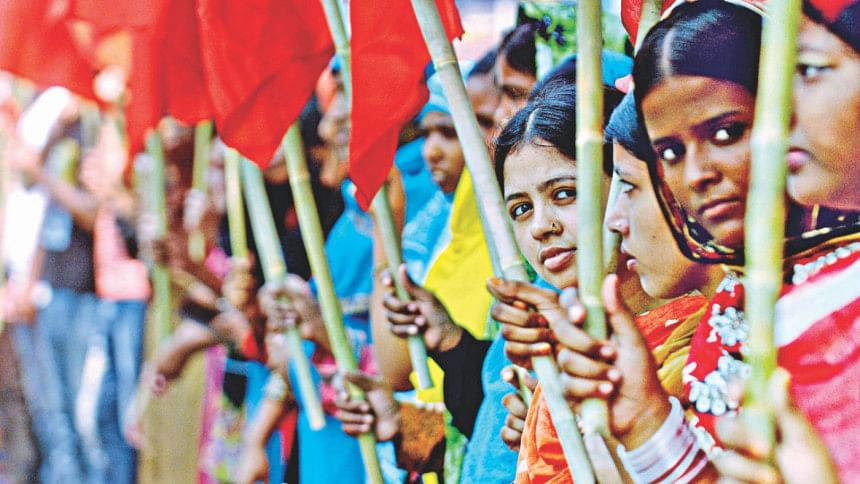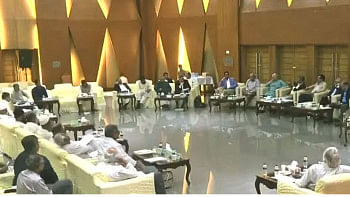How women labour leaders are changing the landscape in RMG

Sharifun is a soft-spoken woman with a big, generous smile. Dressed in a modest saree, the 35-year-old looks like a kindly grandmother, much older than she actually is. However, this shy, demure façade hides the fact that she is a fierce and successful labour leader who withstood months of intimidation and abuse in order to establish a union at her factory in Dhaka's Ashulia industrial hub. In 2017, as president of the union, she successfully negotiated a collective bargaining agreement (CBA) with the factory owners and management that has greatly improved the rights and benefits of the workers. These include: an eight percent annual increment in wages (factory owners are only legally obligated to provide five percent), doubling the amount of festival holidays (22 as opposed to the legally mandated 11), improved maternity benefits and day-care facilities, among others. In a country where ensuring the workers' minimum legal rights is still a challenge, what Sharifun has managed to achieve is truly extraordinary.
In Bangladesh, the rate of unionisation in the ready-made garment sector is very low—less than 10 percent of the factories are unionised. While success stories like Sharifun's are still rare, more and more women workers are stepping forward to take on leadership responsibilities in their factories. When women, who represent the majority of the workforce, are in a position to articulate their demands, it leads to a much more nuanced conversation on working conditions that goes beyond the narrow focus on building and fire safety. For example, at another factory in Dhaka, union leader Bilkis was able to negotiate a CBA that guarantees that the employer would pay for the cost of ultrasound check-up for pregnant workers. It was also agreed that pregnant workers would be given relief from physically demanding duties in the later months of their pregnancy. Such provisions represent a giant step forward in an industry where firing workers for becoming pregnant is still a widespread practice.
Both Sharifun and Bilkis were trained on labour rights by Awaj Foundation, a workers' rights NGO founded by former garment worker and trade union leader Nazma Akter. At Awaj, garment workers are taught about their rights and responsibilities under the Bangladesh Labour Law as well as international labour standards. They are also taught about negotiation, collective bargaining and how to develop harmonious industrial relations.
However, knowing about rights and implementing them in the factories are quite different matters. There are vast power imbalances between factory owners, management and the workers and deep distrust towards unions. Female workers are at a particular disadvantage because of the threat of gender-based violence and verbal abuse at the workplace that is often employed to keep workers in line. A crucial aspect of Awaj's work in leadership building is to cultivate confidence among women workers so that they are able to speak up and raise their demands. As Sharifun said, "A few years ago, I couldn't even think of speaking in front of the factory managers, but now I speak with them regularly to solve issues raised by workers. Even the factory owner is in regular contact with me and treats me with a lot of respect."
In order to create a more conducive environment for dialogue between the different parties, Awaj also trains the management at factories to raise their awareness on workers' rights and educate them about their obligations. These exercises in collaboration and trust building is starting to bear fruit—in 2017, with the support of Awaj, collective bargaining agreements were negotiated and signed by women labour leaders in six factories, covering over 16,000 workers.
However, the picture is not always rosy. Yasmin, another labour leader, took an initiative to start a union at her factory to address problems workers were facing, such as not receiving legally mandated maternity benefits, lack of sick leave and being subjected to arbitrary dismissals. When the management found out that an application for a union had been submitted, they fired over 50 workers involved in the initiative, including Yasmin. Moreover, they enlisted the help of local political operatives and thugs to intimidate and harass the union leaders. Yasmin has been unemployed for six months while she fights a court case against the factory owners, causing enormous financial and psychological strain on her and her family. Unfortunately, stories such as this are far too common as many garment owners continue to exploit the lack of enforcement of the freedom of association.
The fact is, unions are not only good for the workers in order to enable decent working conditions, they are also beneficial for factory owners and management. This has been demonstrated in all the six factories where Awaj supported the development of CBAs last year. Morjina, the president of the union at one of these factories in Dhaka's Tongi industrial area, said that productivity at her factory has increased greatly since the formation of the union. Before unionisation, the factory would produce around 200,000 "pieces" a month and now they produce over 340,000 pieces. She pointed to greater employee satisfaction as one of the key reasons for increased productivity. Although Morjina had to fight hard to establish the union, the owners now acknowledge that it has made an enormous contribution towards increasing production. The presence of a union also helps to mediate conflict between workers and owners, which leads to fewer factory closures and shipments can be made on time. Morjina said, "We wanted to show everyone that a unionised factory can work and that it can be better than other factories. We are now the most productive factory in our area."
Five years after the brutal wake-up call of Rana Plaza, significant progress has been made in ensuring fire and building safety in the garment sector in Bangladesh. However, the industry falls far short in ensuring decent working conditions for garment workers. Wages in the sector are the lowest among major garment manufacturing countries and gender-based violence at the workplace is prevalent. At the same time, this sector remains an essential provider of livelihood for low-income women in the country and the main engine of our economic growth. Representative unions led by women workers offer the best way to ensure that this crucial sector works for both the workers and the economy. Women leaders such as Sharifun, Bilkis and Morjina are proving that what is good for the workers is also good for business. Sustainable development of the garment sector depends on empowering and supporting more women leaders like them.
Farzana Nawaz is a capacity building consultant with the C&A Foundation.





Comments